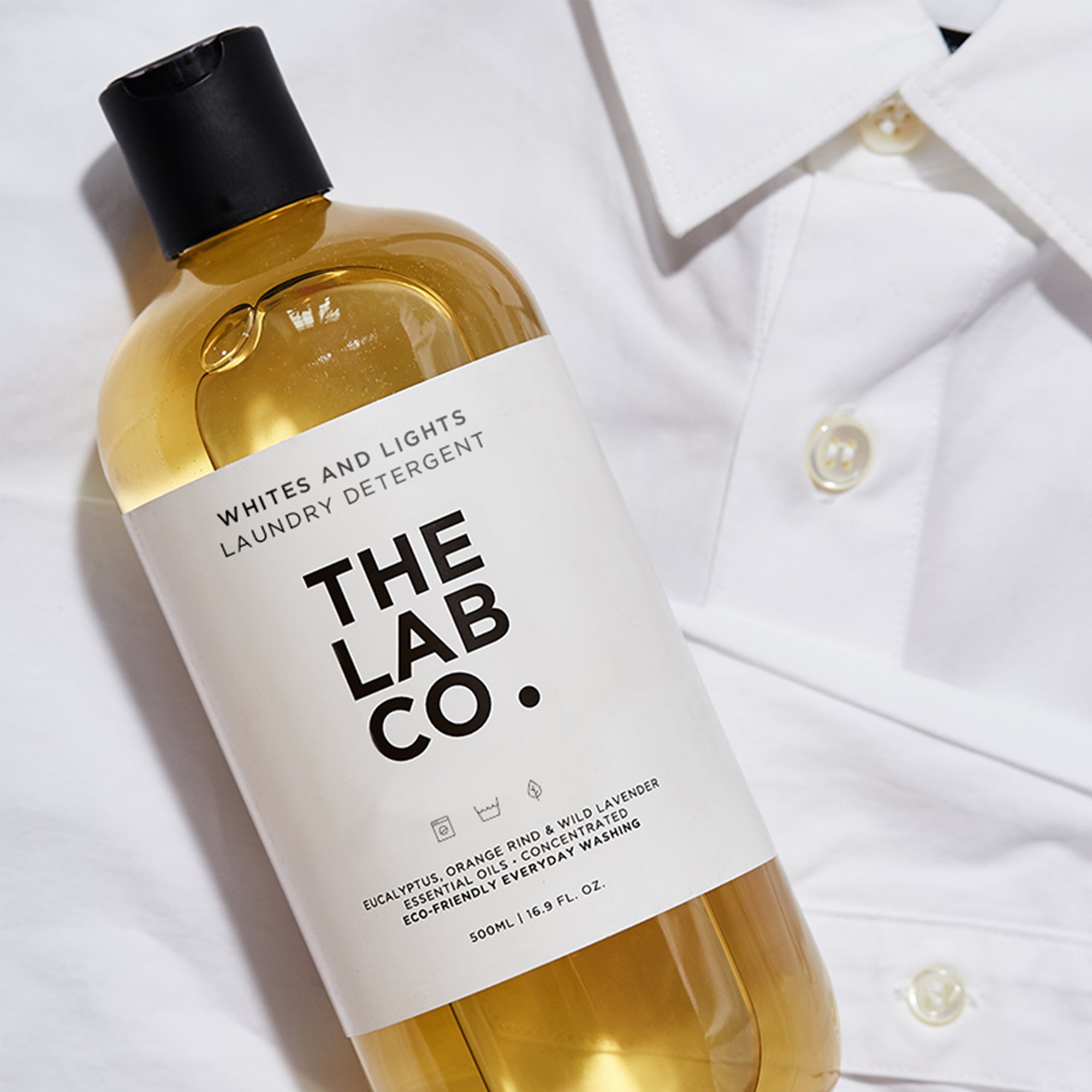
HOW TO GET WHITES WHITE, WASH AFTER WASH
A TLC PRO GUIDE ON HOW TO WASH WHITE CLOTHES
The plain white t-shirt is one of the few universally treasured clothing items due to its versatility. There’s no limit on what it can be paired with, whether dress shoes, heels, a suit or a dress. The white t-shirt is favoured by everyone from farmers to models – even the messiest jobs can’t deter an individual away from wearing one.
What’s more, you don’t have to wear yourself thin trying to ensure they look fresh and brand new after every wash either, but there are a few simple steps you can incorporate into your laundry routine to help keep your white clothes white. There’s nothing worse than finding yellow stains on armpit areas or stains on white jeans, and we agree. Read on to get expert advice on how to keep your whites, white, how to wash them, and more!

HOW TO WASH WHITE CLOTHES TO KEEP THEM LOOKING BRIGHT
PRO TIPS
TIP 1: SEPARATE YOUR ITEMS
It’s important to separate your items by colour and fabric type. Separate your whites from coloured items and group your wash by fabric type, as some items may require a gentle cycle or hand wash, such as silks and delicates, woollen clothing and undergarments.
TIP2: STOP WHITES FROM GOING GREY IN THE WASH
The main cause for your whites turning grey in the wash is if you use the wrong detergent and an incorrect amount of it. This can cause limescale and soap scum to accumulate on your clothes and give them a grey coating. The main solution is to use natural, plant-based and non-bio laundry detergents correctly measured. Here is why:
Opting for a non-bio laundry detergent intended for white clothing will protect the integrity of the fabric fibres. Biological detergents often weaken the fibres and shorten their lifespan.
Use detergents that have plant-based ingredients. Traditional detergents are often formulated with harsh chemicals like chlorine bleach that actually cause yellowing and greying over time.
Use the correct amount of detergent for your water hardness and how soiled your clothes are. Using too much detergent will leave residue on your clothing that will cause early deterioration and discolouration of the fibres. Not using enough detergent will not get rid of the dirt that will over time change the colour of the fibres.
TIP 3: TREAT STAINS WITH A STAIN REMOVER
Stain removers are the perfect ammunition against stains. Use the solution before or after a wash or on the go. Spray directly onto the stained area and leave it to rest for 10 minutes before popping your items into the wash.
TIP 4: USE COLD WATER
‘What temperature to wash white clothes?’ This is one of the most frequently asked questions we get at The Lab Co. Our recommendation is - to use cold water! Not only does using cold water conserve energy, it is less taxing on textiles, meaning it will help extend the lifespan of your garments. Combine cold water with our specialist laundry detergent for white clothes and love your favourite items for longer!
TIP 5: SOAK BEFORE WASHING
Soak your whites in a bowl or basin of hot water with two tablespoons of baking soda for 2 hours before putting them in the washing machine in order to rid them of grey tones.
TIP 6: USE WHITE VINEGAR OR LEMON JUICE
How to wash white clothes without bleach? Add white vinegar to your wash! This is our favourite household hack to get whites white. Add between 4-8 tablespoons of white vinegar to the pre-wash compartment when machine washing. This has been known to pull the grey and yellow tones that have stained your whites out of the fabric and help renew their original colour.
Lemon juice, like vinegar, works as a natural alternative to chemical bleach and thus works wonderfully as a whitener. Cut two lemons into slices and boil in a large vat of water and then remove from the heat. Add your white garments to the water and leave to soak for an hour then wash clothes as usual. You can also add the lemon juice alongside your chosen detergent to the washing machine or a bowl if hand washing and wash as usual.
TIP 7: CHECK ALL FABRIC CARE LABELS
This may seem time-consuming, but you may only need to do it once. It’s important to always check a garment’s fabric care label to ensure you wash it the right way. Look for whether the garment can be machine-washed or require hand-washing, along with the recommended water temperature and drying method.
TIP 8: DRY YOUR WHITES OUTSIDE
Hang your items to dry outside in direct sunlight. The sun acts as a natural bleach and gives your garments the desired result without having to use harmful chemicals. Please note that drying in direct sunlight is not recommended for coloured items as this will cause them to naturally fade and deteriorate quicker. Here are some steps you can take to dry clothing in a machine dryer without damaging the fibres:
- Before putting your clothes in the dryer, make sure to sort them based on fabric type. This will help you to set the appropriate heat and drying time for each load.
- Choose the appropriate heat setting for the type of fabric you are drying. For example, use low or medium heat for delicate fabrics like silk or wool, and high heat for sturdier fabrics like cotton or denim.
- Don't overload the dryer. Overloading the dryer can cause clothes to wrinkle, take longer to dry, and may cause damage to the fibres. Make sure to leave enough space for air to circulate in the dryer.
- Avoid over-drying and high heat. Over-drying can cause fibres to become brittle and prone to damage. Set your dryer to the appropriate time or use the auto-dry setting to avoid over-drying your clothes. Using high heat can have the reverse effect and cause yellowing and damage to the fibres.
HOW TO WASH WHITE CLOTHES IN A WASHING MACHINE
Before loading the washing machine:
- Take everything out of the pockets.
- Close all zippers. This will ensure that they can’t cause any damage to your clothing mid-cycle.
- Turn delicate items inside out. T-shirts that are screen printed should be washed inside out and only at low temperatures to avoid shrinkage and damage to the print.
STEP 1:
Sort your laundry and load the washing machine with white items only. Follow our simple guide to categorising your clothing to make your washing routine a lot easier and hassle-free.
STEP 2:
Pre-treat stains where necessary. Our spot stain remover can be applied to items with stained areas 30 minutes before being washed. This will ensure that you can wash your items on a regular, warm water cycle.

STEP 3:
Use a non-bio detergent that’s formulated for white clothing. We recommend using a natural detergent with plant-based ingredients, as harsh bleaching chemicals often contribute to the deterioration of the fibres.
STEP 4:
Set to the right cycle and temperature. Hot water helps break down tough dirt and stains but can damage the fabric fibres. We recommend pre-treating any difficult stains beforehand and washing on a regular 40° cycle.
Always check the care label first to check the ideal washing cycle temperature.
STEP 5:
Remove your freshly laundered white clothes from the washing machine and hang them to air dry. For machine drying follow our tips above.
HOW TO HAND WASH WHITES
Before hand washing your whites, pre-treat any tough stains. This will make sure your items come out whiter and brighter.
STEP 1:
Fill a bowl or basin with lukewarm water. Avoid using hot water as this can cause damage to the integrity of the fabric fibres.
STEP 2:
Pour 10-20ml of a non-bio detergent formulated for washing white clothes. Using plant-based detergents that have no harsh chemicals will ensure the fibres of the fabric are protected during the washing.
STEP 3:
Submerge your garments into the solution and work the detergent into the clothes by gently rubbing them, focusing more attention on stained or discoloured areas. Leave to soak for 30 minutes and then rinse the garments under cold running water.
STEP 4:
Remove your freshly laundered white clothes and hang them to air dry. For machine drying follow our tips above.



